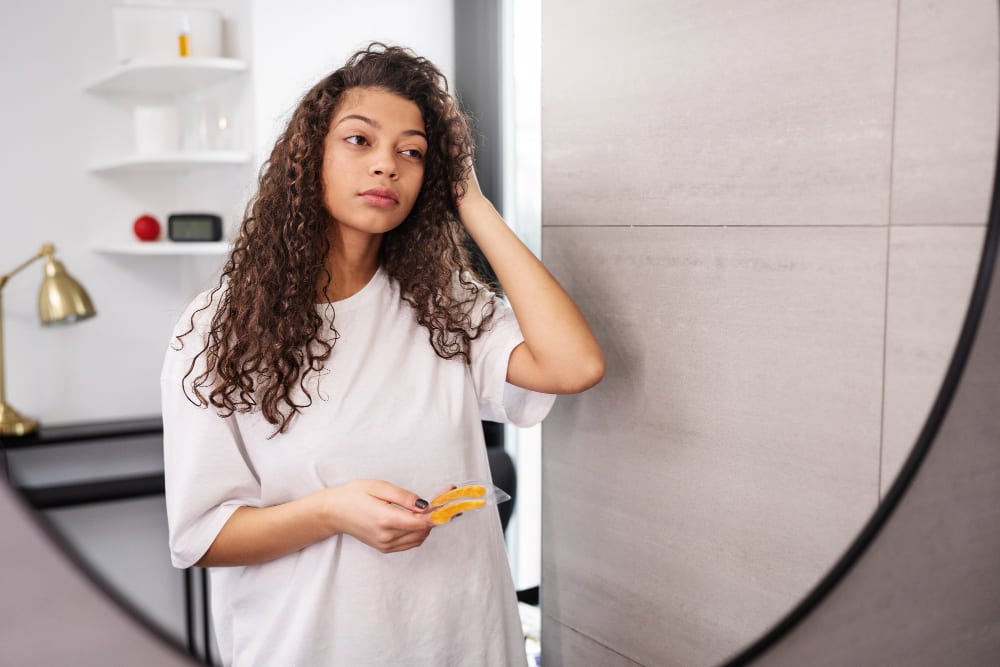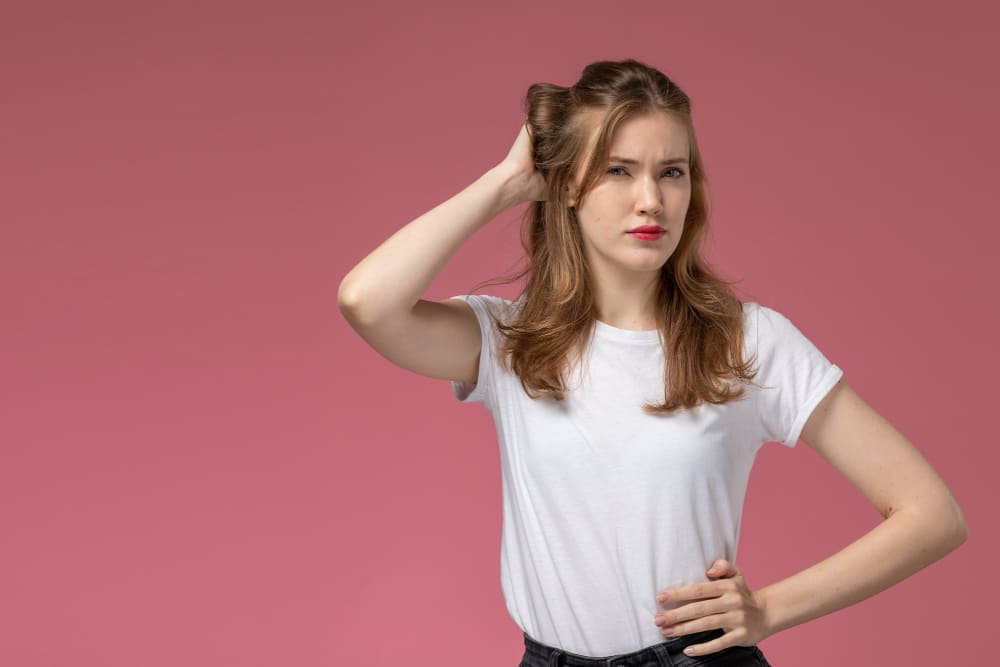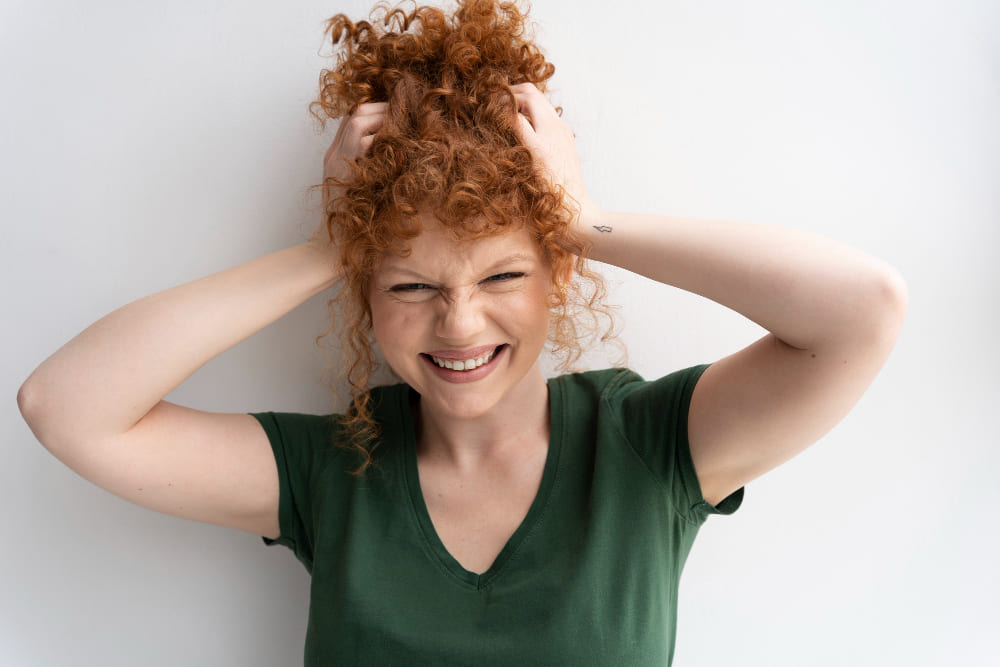Greasy hair is probably the most frustrating and widespread hair problem, leaving your roots limp, lifeless, and looking like you have forgotten to wash (even if you hadn’t). If you have ever looked into the mirror and wondered, “Why is my hair greasy again?” — you are not alone. Whether your hair quickly becomes greasy or starts to feel oily just hours after you wash it, it may feel like a never-ending cycle.
And the good news: greasy hair is not necessarily a forever problem — it is a warning sign your scalp is sending you. From product buildup to overwashing to your daily habits, several sneaky culprits could be hiding. Sometimes it is not what you are doing, but not doing — like neglecting regular clarifying treatments or touching your hair excessively. Other times, it is hormonal or environmental. In this guide, we will break down the most common causes of greasy and oily hair and show you how to have less greasy hair, step by step.
What Causes Greasy Hair?
So, do you ask: why is my hair so greasy? Let’s find the answers. When your scalp produces too much sebum (natural oil), it builds up at the roots and makes your hair appear greasy. This is a natural process, but several factors can make it worse:
Overwashing or Underwashing
Shampooing too frequently can provoke oil production, since your scalp tries to replace lost natural oils. Not shampooing frequently enough can lead to an oil, dirt, and product buildup on the scalp, however. The balance point is the solution to avoiding oily, greasy locks. A majority of people with oily hair find that shampooing every 2–3 days is best. If your scalp remains oily for a short while, then once a week, use a mild clarifying shampoo. Do not scrub strongly — scrubbing roughly will aggravate your scalp as well as make it oilier. Observe the texture of your hair for a couple of days and be flexible accordingly.
Hormonal Changes
Teenagers, expectant women, or those experiencing hormonal changes (such as menstruation or menopause) might find their hair more oily. Hormones cause sebaceous glands to produce more, resulting in too much oil. This is often the case during puberty or hormone therapy. If your hair has become oily all of a sudden and nothing about your daily regimen is different, hormones could be the cause. You can also cradle your scalp with light, balancing shampoos and frequent rinses with cold water. A routine can assist in balancing the effects until hormone levels equalize. If it continues, it may be worth a visit from a dermatologist or an endocrinologist.
Wrong Hair Products
Using heavy conditioners or styling products not made for your hair type can weigh down your hair and make it look oily. If your hair greases easily, use light, silicone-free products. Use products that are “volumizing”, “clarifying”, or “oil-free”, noted on them, especially at the scalp region. Do not use conditioner at the roots — use only mid-lengths to ends. Dry shampoos can also be used to extend the time between washes, but be sure to wash thoroughly to prevent buildup. A clarifying wash using apple cider vinegar or a scalp scrub every week can also re-center your product balance. Always patch-test new products to check that they are suitable for your scalp type.
Touching Your Hair Too Often
Your fingers leave oil and grime on your hair every time you touch it. Brushing or finger-raking of hair excessively makes the greasiness accelerate. This includes twisting, resetting ponytails, or excessive brushing. Avoid it by styling your hair in ways that discourage constant manipulating, like buns or braids. Clean your brush once in a while, as it also leaves oil on your hair. A satin or silk pillowcase will prevent friction buildup overnight that stimulates scalp oil. Conditioning your hands to keep away from your hair will make a surprisingly big impact on managing oil.
How to Tell If Your Hair Is Greasy
If your hair gets greasy fast, it might be due to overwashing or using heavy products that clog your scalp. Wondering how to tell if your hair is greasy or just looks wet? Here are a few quick signs:
- Your roots look darker or shinier than the rest of your hair. This is typically because oil will reflect more light than clean hair. It may cause it to look wet even though your hair is dry to the touch. If your roots start to look greasy after a few hours of shampooing, your scalp may be secreting too much sebum.
- Your hair feels heavy or tacky near the scalp. This sticky feeling can be due to oil mixing with product residue or sweat. It can also cause redness or itching later on. If that is the case, you might have to wash your scalp more often or switch to lighter styling products.
- It looks flat and lacks volume, even when styled. Oily and greasy hair is prone to weighing itself down, which makes it challenging to achieve volume or bounce. The most wonderful blowouts can be subpar if the roots are too oily. You might notice your oily hair clumping into chunks instead of smoothly flowing.
- You can see buildup or residue when you part your hair. This can appear as a whitish or yellowish coating close to the scalp. It can be built up or a combination of dead skin cells, oil, and dirt. Exfoliating daily or using a clarifying shampoo can reduce this visible buildup.

How to Make Hair Less Greasy: Simple Solutions
If you are dealing with oily greasy hair regularly, try these expert-backed steps to reset your routine:
Alter Your Wash Frequency
Instead of washing daily, try every other day, or two or three days. This gives your scalp a chance to control oil production. Overwashing strips away natural oils, and, as a rebound, your scalp produces more oil. Gradually increasing the wash interval gives your scalp time to adjust. If your hair becomes oily in the transition, try using a light dry shampoo to stay clean.
Select the Correct Shampoo
Pick a clarifying or gentle detox shampoo once a week to clean out buildup. For everyday use, opt for a sulfate-free shampoo that is intended for oily and greasy hair. Clarifying shampoos work by breaking down residue from products and sebum that can lead to greasy hair. Sulfate-free versions are less harsh and keep your scalp in a healthy balance. Avoid overusing clarifying products, which dry out the scalp.
Don’t Use Conditioner at the Roots
Use conditioner from mid-length to ends only. This keeps your scalp lighter and prevents that heavy appearance. Conditioner near the scalp will weigh your hair down and make it greasier faster. Focus on drier sections of your oily hair that truly need the moisturizer. Use a wide-tooth comb in the shower to work conditioner through your ends.
Apply a Dry Shampoo in Between Washes
Dry shampoo absorbs oil and gives your hair volume without water. It’s perfect if your hair tends to get oily fast or needs a midday pick-me-up. Spray it onto your roots and let it sit for a few minutes before massaging it in. Choose a residue-free formula so you won’t get buildup. Some dry shampoos also leave a pleasant scent, making you smell fresher throughout the day.
Rinse with Cool Water
Hot water can stimulate the oil glands, while cold water seals the hair cuticle and reduces oil buildup. Cool rinses also add shine and make your hair look smoother overall. It is a simple step that can make a big difference in how long your hair will stay clean. If a full cool rinse is not comfortable, even a final 10-second cool rinse at the end will help.
Oily Hair or Just Product Buildup?
Sometimes, your hair looks greasy because of product residue, not oil. If you use serums, creams, or styling sprays often, a monthly clarifying treatment can help remove buildup. Visit the HairSocial Hair Menu to explore targeted treatments for oily and greasy hair types.
When to See a Specialist
When your hair gets greasy fast, switching to a sulfate-free shampoo and adjusting your wash routine can make a big difference. If you have tried everything and your hair is still excessively greasy, you might be dealing with a scalp imbalance or condition like seborrheic dermatitis. A dermatologist or trichologist can help identify the cause and offer solutions tailored to your hair and skin type.

Final Thoughts
So, why is your hair so greasy? The answer may lie in your washing habits, product choices, or even your hormones. The good news? With a few tweaks, you can easily build a routine that makes your hair less greasy and keeps your scalp healthy.
Need more help maintaining healthy hair? Explore expert guides on HairSocial or check out our favorite moisturizing tips to balance oil production naturally.


Leave a Reply